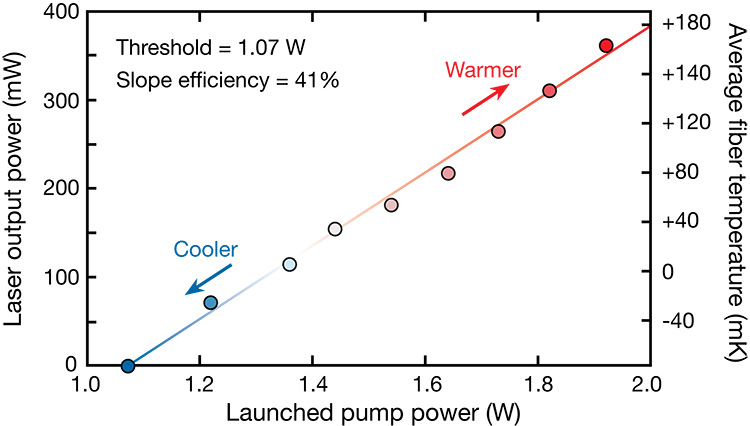 Output versus pump power for Yb-doped silica fiber laser, with heat mitigation via anti-Stokes fluorescence cooling. Color gradient represents the average temperature of the fiber relative to ambient temperature. [J. Knall et al., Optica 8, 830 (2021)]
Output versus pump power for Yb-doped silica fiber laser, with heat mitigation via anti-Stokes fluorescence cooling. Color gradient represents the average temperature of the fiber relative to ambient temperature. [J. Knall et al., Optica 8, 830 (2021)]
In optically pumped lasers, heat generated by the quantum defect, arising from the fundamental energy difference between the pump and laser photons, causes detrimental fluctuations in the spatial mode, frequency and power of the output—and, ultimately, catastrophic failure at high powers. Common heat-mitigation techniques use bulky mechanical coolers that introduce vibrations and lead to frequency and amplitude noise. These sources of noise can be particularly damaging when attempting to produce laser signals with the ultra-low laser intensity noise and ultra-stable frequency that are increasingly required for advanced metrology applications, such as fiber sensors1 and gravitational-wave detection.2
Anti-Stokes fluorescence (ASF) cooling is a promising vibration-free alternative to laser heat mitigation. ASF involves pumping the laser’s active ion at a photon energy lower than the mean fluorescence energy of the laser transition. The electrons are therefore excited primarily in the lower level of the ions’ upper energy manifold. To satisfy the Boltzmann distribution, they must acquire energy from the host’s phonon bath to redistribute themselves among the manifold’s higher levels. This acquired energy is removed from the host when the electrons relax back to the ground state and emit photons with a mean energy greater than the pump photon energy. As the photons escape from the host, the host cools.
Although ASF cooling has been used in exotic fluoride fibers, it has only recently been successful in a silica fiber,3 by far the most common fiber laser host. In the last year, our multi-university team has capitalized on this significant advancement to demonstrate both the first radiation-balanced silica fiber amplifier and the first radiation-balanced laser, devices that amplify or produce light while remaining below ambient temperature.4,5
These devices employed highly ytterbium-doped silica fiber fabricated using well-established industrial techniques.3 Particular attention was paid to the glass composition to minimize extraneous internal heating due to concentration quenching and residual absorptive losses. The fiber amplifier was core-pumped at 1040 nm to create both cooling and amplification at 1064 nm, resulting in 17 dB of gain.4 In our experiments, the ASF cooling completely negated the heat generated by non-radiative relaxation involved in the amplification process. The fiber laser, pumped at the same wavelength, produced 114 mW of 1065-nm light with a 41% slope efficiency.5 The average temperature during lasing was within 3 mK of room temperature.
We believe that these breakthroughs open the door to a new generation of fiber lasers and amplifiers with unprecedented coherence and stability. Given the prominence of silica fiber lasers, this new functionality is expected to have far-reaching benefits to many applications in sensing research, manufacturing and defense.
Researchers
J. Knall, P.-B. Vigneron and M.J.F. Digonnet, Stanford University, Stanford, CA, USA
M. Engholm, Mid Sweden University, Sundsvall, Sweden
T. Boilard and M. Bernier, Université Laval, Québec, Canada
P.D. Dragic, University of Illinois at Urbana-Champaign, Urbana, IL, USA
J. Ballato, Clemson University, Clemson, SC, USA
References
1. S. Foster et al. J. Lightwave Technol. 35, 3514 (2017).
2. M. Steinke et al. J. Sel. Top. Quantum Electron. 24, 3100613 (2018).
3. J. Knall et al. Opt. Lett. 45, 1092 (2020).
4. J. Knall et al. Phys. Rev. Lett. 127, 013903 (2021).
5. J. Knall et al. Optica 8, 830 (2021).
